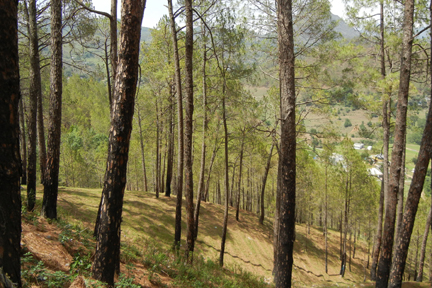FOREST FIRES
DIPANJAN GHOSH
Forest fire is a natural part of the circle of forest life in most types of forests and grasslands of the world. Both fire and forest are intimately and intricately related to each other. Natural sources like lightning, volcanic eruption, etc., can cause
forest fires. Lightning induced fires are quite common in boreal forests where the forest floors are rich in raw humus deposits and with minimal microbial activities.
Fires in the forest are classified in to three categories. Ground fire or muck fire spreads very slowly and occurs beneath the top soil. They may continue to burn for months and destroy vegetative cover of the soil. Creeping or surface fire, usually spreads
slowly over the forest floor, burning with a low flame. Surface fire may spread rapidly by wind over the vegetation of the lower canopy composed of grasses, herbs and shrubs. Crown fire is the most unpredictable fire that consumes the entire upper canopy of
a forest.
Dry deciduous forest and grassland ecosystem of Eastern Himalaya is in conflagration during the dry season (Photo: Souvick Mukherjee).
In India, forest fire is a seasonal phenomenon that occurs mainly in grasslands and various types of forest compositions. For instance, Himalayan montane forest vegetation and shola grassland ecosystem of the Western Ghats encounter fire incidence in regular
intervals, mostly during the dry season. However, fires can occur in rainforests too, but under very extreme weather conditions.
Sometimes fires are set on to the forest to improve the quality of pasture land and to create fresh grass growth for cattle; to facilitate the collection of various forest produce such as tender leaves, honey, lichens, dry grasses and seeds. Moreover,
smugglers and poachers burn forest area to have more visibility and to avoid encounter with wild animals. Sometimes people set fire to scare away wild animals from villages and agricultural fields.
Controlled fire or swailing is a technique used as a genuine wild land management measure and are performed by trained personnel under the supervision of forest department, mainly in United States, Canada and Australia. In Kaziranga National Park of Assam,
the grasslands are burnt every year. Also there are some dry forests in South India where patches are burnt by forest department along roadsides to increase their efficiency as fire breaks in case of wildfire.
Certain plants must have fire at regular intervals in order to regenerate (Photo: Ayan Mondal).
Controlled burning or prescribed burning reduces the possibilities of wild fires. Clearing leaf litters, dropped branches, inflammable grasses, and ground vegetation from the forest floor with low intensity controlled fires can help in preventing furious
wildfire incidents that spread out of control and completely damage forests.
Fire has several positive as well as negative ecological impacts. Low intensity fire that does not grow out of control has collective advantages to the ecosystems and its various species. Forest fire removes low-growing undergrowth and small tree species
as well as cleans the forest floor of debris. Fire opens up forests so that sunshine can get through which encourage plants to grow. Forest fire perpetuates certain fire dependent plant species and also helps in regeneration (Figure 2). Besides, certain conifers
are serotinous, i.e., they open cones to disperse seeds after getting heat from fire. Wild fire, though indomitable, determines the spread of the vegetation in certain areas. For instance, the composition of the vegetation at all altitudes in the Himalayas
has been much figured by fires (Figure 3). Many forest trees struggle against certain pathogenic or non-pathogenic diseases and insect infestations. Forest fire kills harmful pests, parasites, fungi as well as invasive weeds and keeps the forest healthy.

Blue pine (Pinus wallichiana) habitat in a post-burn forest of Central Himalayas (Photo: Dipanjan Ghosh).
Forest fire results a huge outcome of smoke due to biomass burning (Photo: Souvick Mukherjee).
Forest fire causes a huge outcome of smoke, mainly due to large scale biomass burning (Figure 4). Various gases of biogenic origin such as carbon dioxide, carbon monoxide, methane, non-methane hydrocarbons, nitrous oxide, and nitric oxide are produced
by such burning incidents. In fact, forests generally maintain the balance of gases like oxygen and carbon dioxide in the atmosphere. However, the gases generated due to forest fire not only pollute the atmosphere but also contribute to green house effects
and global warming.
Blackbuck (Antilope cervicapra) on open grassland in Velavadar NationalPark, Bhavnagar, Gujarat. The native bunchgrass and herbs grow fast after a fire which gives the antelope plenty of food to eat (Photo: Aisharya Sridhar).
Most of the animals remain unharmed as they can take temporary shelter in unburnt or already burnt areas. Fires burn the eggs of birds, destroy the young animals and damage their habitats. As habitat is burnt some animals are unable to move to other areas,
due to unfamiliarity. Birds take advantage of their flight to escape fire. Snakes, lizards and some small mammals avoid the fire by taking refuge in deep underground burrows and crevices. Surprisingly, some non-burrowing animals are killed by suffocation,
when trapped inside smoke laden burrows or pits. Some cold blooded animals including snakes are seen to bask in burnt areas where the ground is warm. Burning of thick grasses affects both prey and predator, as cover for both is lost.
(Basically a teacher by profession, Dipanjan Ghosh is equally well-known popular science writer and one of the Editors of the journal ‘Indian Science Cruiser’ published from Kolkata. E-mail to: dpanjanghosh@gmail.com for sharing
your views.
Postal Address: Chotonilpur Pirtala, PO Sripally, Dist. Bardhaman 713 103, West Bengal.)